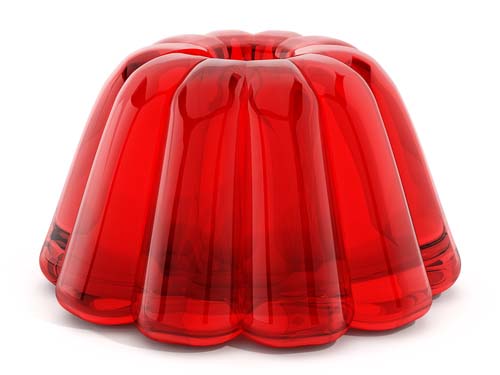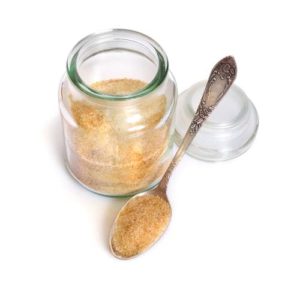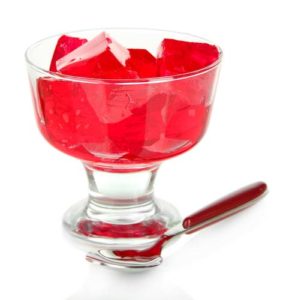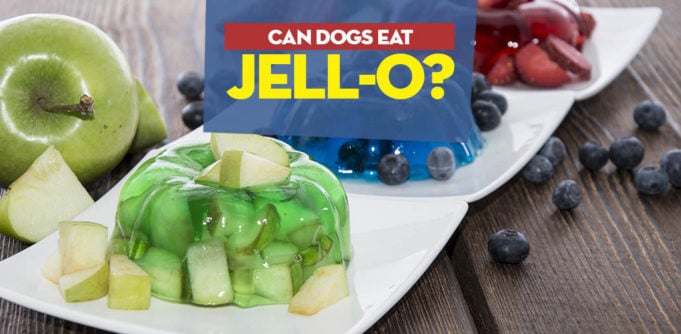Jell-O is a bright-colored dessert that is considered a fun food, in particular for children. Containing powdered gelatin, sugars, and artificial sweeteners, Jell-O (or jello), or any name brand gelatin treat, is a tasty way to end a meal. But can dogs have jello without any issues?
If you've been wondering, “can I give my dog jello,” the answer is NO – jello is not recommended for dogs to consume. While gelatin for dogs that makes up a big part of jello may be beneficial, most other ingredients of this treat are bad for dogs.
In this article, we'll take a closer look at Jell-O, what it's made of, can dogs have jello in any amount and what are the benefits and side effects of feeding it to canines.
ALSO READ: Can Dogs Eat Marshmallows?
What is Jell-O?
Jell-O is a dessert that is sold in powdered or ready-to-eat form. It comes in a variety of flavors and colors, from cherry to peach to pina colada. The actual powdered portion contains gelatin, a protein that is created from the collagen taken from boiled connective tissues, bones, and animal products.
This is what Jello-O looks like:

This type of dessert is also full of artificial flavors, sweeteners, and sugars. Originally a dessert of royalty, Jell-O has gone on to become a household staple and a quick and easy dessert to whip up which is also very inexpensive and relatively low in calories.
RELATED: Lentils for Dogs – Can They Eat Them?
Jello for Dogs 101
Can Dogs Eat Jello?
 So can dogs have jello occasionally? Although Jell-O is a sweet treat for humans, it is not an acceptable food for dogs. Its nutritional value for canines is minimal because it's so full of sugars and food coloring that over time, too much Jell-O can cause serious illnesses or diseases.
So can dogs have jello occasionally? Although Jell-O is a sweet treat for humans, it is not an acceptable food for dogs. Its nutritional value for canines is minimal because it's so full of sugars and food coloring that over time, too much Jell-O can cause serious illnesses or diseases.
Additionally, some forms of Jell-O may have the artificial sweetener Xylitol in them, a sweetener that can be deadly to dogs. Normally, it's best to avoid feeding dogs jello and opt for more nutritious snacks for dogs, fruits and vegetables.
The only nutritional part of jello that theoretically may be good for dogs is gelatin. Gelatin is made of almost pure protein (99% of it). It's not a complete protein because it's missing some essential amino acids but for humans it can still be very beneficial.
- Gelatin improves bones and joint health (1, 2, 3)
- Gelatin improves hair and skin (4, 5)
- Gelatin may improve memory and brain function (6, 7)
- Gelatin may help with weight loss (8, 9)
- Gelatin may help with sleep (10, 11)
- Gelatin may prevent cancer growth (12, 13)
- Gelatin helps to prevent liver damage (14, 15)
- Gelatin may help with gut flora (16, 17)
There are many benefits of gelatin for dogs and people; however, feeding jello to dogs isn't a good enough reason. Instead, it'd be better to opt for pure gelatin over jello.
1 Benefit of Jell-O for Dogs
 As discussed above, jello does include powdered gelatin, derived from the collagen removed from cartilage, bones, and animal products, which are typically good for dogs to have in their diets.
As discussed above, jello does include powdered gelatin, derived from the collagen removed from cartilage, bones, and animal products, which are typically good for dogs to have in their diets.
The issue is the source of the gelatin, and in the case of Jell-O, the good from gelatin is far outweighed by the nutritionally deficient sugars and artificial sweeteners. Typically, gelatin on its own can be beneficial to dogs in the following ways:
- Glycine is an amino acid in gelatin that helps protect dogs from brain damage and seizures.
- Gelatin has anti-inflammatory properties that can help dogs who suffer from arthritis or conditions like hip dysplasia, degenerative joint disease, or irritable bowel syndrome.
- Gelatin promotes easier digestion of carbohydrates and grains.
- Gelatin can alleviate gastrointestinal issues such as upset stomach and diarrhea.
It is possible to make homemade gelatin for your dog to avoid the sugars and additives found in Jell-O. That is the only way to give your dog gelatin and have him reap the benefits without those benefits being canceled out by nutritionally deficient added ingredients.
RELATED: The Reason Dogs Cannot Eat Onions
3 Side Effects of Jell-O for Dogs
1. The added sugars and artificial sweeteners in Jell-O can result in weight gain, heart disease, and diabetes.
 Too much sugar and artificial sweeteners are not good in a dog’s diet. While an occasional serving of Jell-O may be fairly harmless, making Jell-O a regular part of a dog’s diet can mean more severe health problems in the future.
Too much sugar and artificial sweeteners are not good in a dog’s diet. While an occasional serving of Jell-O may be fairly harmless, making Jell-O a regular part of a dog’s diet can mean more severe health problems in the future.
Excess sugars can result in weight gain and obesity over time. Those conditions, in turn, may lead to excessive damage to internal organs, as well as additional stress on joints and bones. These damages may be permanent, even if the dog eventually loses weight through exercise and diet.
A high sugar diet can also contribute to high blood pressure and heart disease in canines. Another health issue that may develop is hypertension. All of these conditions force the heart to work harder to pump blood throughout the body, leading to congestive heart failure.
Additionally, a diet high in sugars and sweeteners may cause a dog to develop diabetes. Obesity causes the body to produce higher levels of insulin because of the higher production of glucose concentrations in the blood. Once the body cannot keep up with the increased insulin demands, diabetes occurs.
2. Too much Jell-O may cause a dog to develop pancreatitis.
The development of sugar diabetes can lead to pancreatitis, a disease where the pancreas becomes inflamed. The pancreas is responsible for aiding in the metabolism of sugar through the creation of insulin and the production of enzymes to assist in digestion.
Aside from damage to the pancreas, pancreatitis may also result in depression, fever, dehydration, and heart arrhythmias.
3. Jell-O may contain xylitol which can be deadly to dogs.
Xylitol is a type of sweetener that is a sugar alcohol that is used in many products for people with no consequences, but the same cannot be said for dogs. If a dog ingests this sugar substitute, serious consequences may follow. This was brought to attention of pet owners through peanut butter feeding to dogs.
Once xylitol is in a dog’s digestive system, it causes the body to absorb it quickly into the bloodstream, prompting the body to produce and release a significant amount of insulin from the pancreas. A dangerous drop in blood sugar may occur, resulting in hypoglycemia, which can occur anywhere from 10 to 60 minutes after the xylitol is ingested. Hypoglycemia can quickly become life-threatening.
Summary
 Can Dogs Have Jello?
Can Dogs Have Jello?
In conclusion, can dogs have jello ever? Unfortunately, while it's tasty treat for us, it is not recommended that dogs eat Jell-O as long as it contains excess sugars, artificial sweeteners, or sugar substitutes like xylitol. All three of these aspects can cause illnesses and diseases either immediately or in the future.
While the gelatin in Jell-O does have nutritional benefits for dogs, it should only be fed to dogs if it is homemade and without sugars or sweeteners added.
READ NEXT: Can Dogs Eat Pizza?













